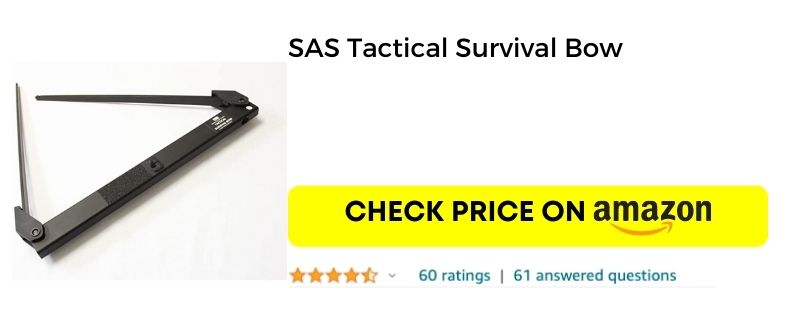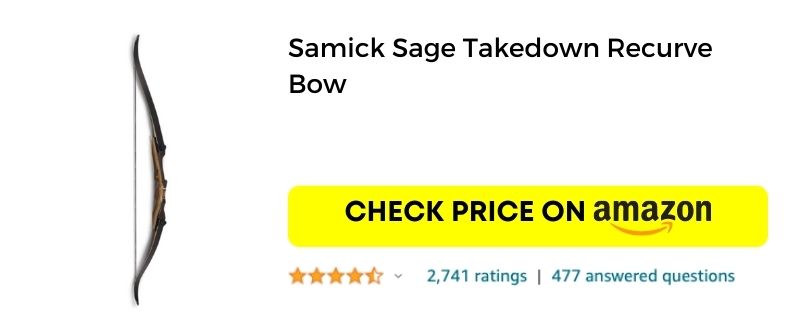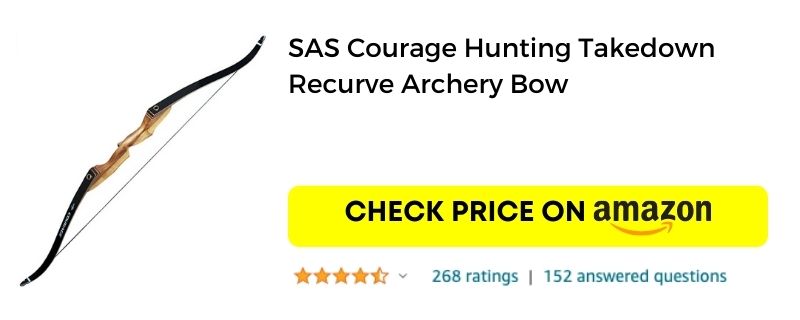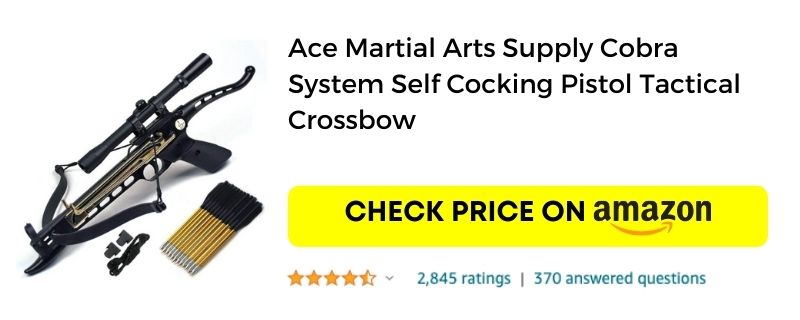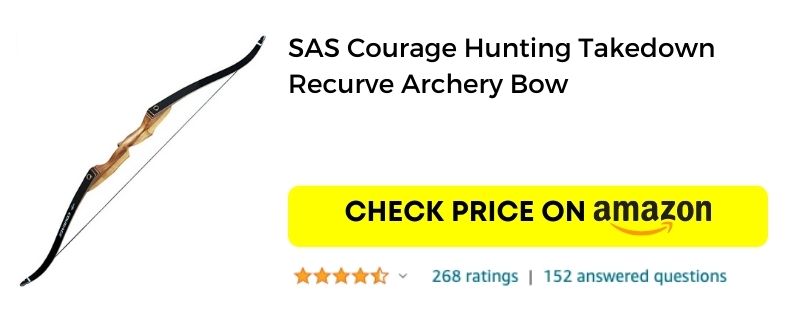7 Best Survival Bows for Hunting & Self-Defense (2023)
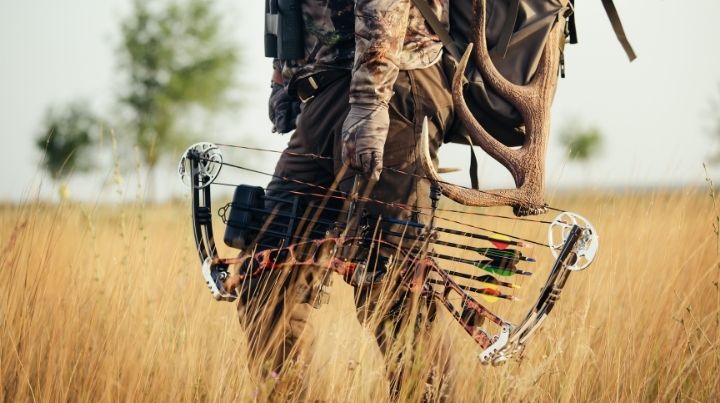

Podcast: Play in new window | Download
There are many different options on the market for survival bows. So, which one is the best?
This article will look at some of the most popular bows and see how they stack up against each other.
We’ll also discuss what factors you should consider when purchasing a survival bow and provide some tips for choosing the right one for your needs.
Disclaimer: This article contains affiliate links that I may receive a small commission for at no cost to you if you choose to purchase a product through a link on this page.
What Are the Best Survival Bows?
Here are my top Mind4Survival picks for the best survival bow to keep you safe and prepared!
1. Tigershark One Piece Recurve Bow
The Tigershark One Piece Recurve Bow is a great choice for any preppers looking to stay safe and prepared.
This bow has an impressive draw weight of 25 – 60 lbs, which makes it perfect for hunting or survival purposes.
The Tiger Shark is made from 100% wood, making it both beautiful and well-functioning.
Features:
- Weight: 3 pounds
- Bow Length Strung: 60″
- Warranty: 1-year manufacturers warranty
Price:
$289.00
You can’t go wrong by checking out the Tigershark One Piece Recurve Bow.
2. SAS Tactical Survival Bow
The SAS Tactical Survival Bow is a modern longbow perfect for those looking for a quality and affordable option.
Combined, the stored length of 21″ with an overall weight of 2.2 pounds makes this folding survival bow just what survival enthusiasts everywhere should consider.
It’s the ability to stash this in nearly any bug-out bag, large purse, or other concealed space storage that makes this compact survival bow desirable for every gray man aficionado.
If you’re considering purchasing a new survival bow, the SAS Tactical Survival Bow can definitely meet your needs.
**Note: Due to the popularity of the SAS Tactical Survival Bow, Amazon on-hand quantities may be limited.
Features:
- Weight: 2.2 pounds
- Bow Length Folded: 21″
- Bow Length Strung: 60″
- Maximum Draw Lenght: 31″
Price:
$219.95
Check out the SAS Tactical Survival Bow.
3. Samick Sage Takedown Recurve Bow
The Samick Sage Takedown Recurve Bow is a 62-inch bow made from high-quality materials.
The bow has a draw weight of 25-60 pounds, making it perfect for people just starting in archery.
It is manufactured with a hard maple laminated riser, making it a lightweight and durable bow.
The bow is excellent for the survivalist on the go.
Features:
- Weight: 2.3 pounds
- Bow Length Strung: 62″
- Interchangeable limbs for extreme versatility
Price:
$149.99
Check out the Samick Sage Takedown Recurve Bow.
4. HYF Takedown Hunting Recurve Bow
The HYF Takedown Hunting Recurve Bow is a top-rated survival bow that comes with everything you need to start hunting.
This bow is perfect for both beginners and advanced archers, as it has many adjustable parts and can be easily adjusted to suit your needs.
It also features the patented HYSUB takedown system, which makes it easy to transport anywhere you go.
If you’re looking for a great survival bow, look no further than the HYF Takedown Hunting Recurve Bow!
Features:
- Weight: 2.3 pounds
- Adjustable Draw Weight: 40 – 55 pounds
- Complete starter kit
Price:
$159.99
Go check out the HYF Takedown Hunting Recurve Bow.
5. SAS Courage Hunting Takedown Recurve Archery Bow
The SAS Courage Hunting Takedown Recurve Archery Bow is an excellent option for anyone looking for a quality survival bow.
This bow is made from durable materials and is easy to assemble and use.
It also features a precision riser with reinforced limbs, making it the perfect choice for any situation.
Features:
- Weight: 2.2 pounds
- Adjustable Draw Weight: 29 – 60 pounds
- Easy to assemble and disassemble
Price:
$139.99
Check out the SAS Courage Hunting Takedown Recurve Archery Bow.
6. Ace Martial Arts Supply Cobra System Self Cocking Pistol Tactical Crossbow
The Ace Martial Arts Supply Cobra System Self Cocking Pistol Tactical Crossbow is a good crossbow for the money.
This awesome pistol crossbow is made of all-metal construction and has a self-cocking system that makes it easy to use.
The crossbow comes with a scope, 39 aluminum arrows, and two 80 pound strings.
Features:
- Self cocking crossbow
- Draw Weight: 80 pounds
- Firing Speed: 165 fps
Price:
$95.95
The Ace Martial Arts Supply Cobra System Self Cocking Pistol Tactical Crossbow is a great low-key option when the S hits the fan!
7. Hungarian Style Handmade Longbow Flagella Recurve
The Hungarian Style Handmade Longbow Flagella Recurve bow is an excellent choice for a survival bow.
It is made of high-quality materials and is very durable. This bow is also accurate and powerful, making it the perfect choice for anyone looking for a reliable survival bow that packs a punch.
Features:
- Weight: 3.31 pounds
- Draw Weight: 30 – 110 pounds
- Draw Length: 33 inches
Price:
$99.99
Get medieval with this Hungarian Style Handmade Longbow Flagella Recurve bow!
Is a Bow a Good Survival Weapon?
A bow is a good survival weapon because it is quiet, versatile, and easy to use.
Compared to other weapons such as firearms, bows are much quieter and can be used without giving away your position.
They are also very versatile, meaning you can use them for hunting and self-defense.
Due to their limited range and stealthy nature, it’s easy to find places to practice your archery skills.
Even urban preppers will find areas from the backyard to local archery stores and clubs to hone their ability.
Finally, bows are relatively easy to use, even for beginners. With a bit of practice, most people can become skilled in archery for their survival purposes.
Types of Bows
Survival bows come in a variety of types and configurations.
With that, knowing which survival bow is right for you is crucial to ensuring that you’re ready to face any survival situation you find yourself in.
Recurve Bows
Recurve bows are one of the most popular bows on the market.
A recurve bow is the traditional image people think of when picturing a bow and arrow.
These great survival bows are known as recurve bows because the ends of the bow limbs curve away from the archer.
They are easy to use and maintain while providing excellent power and accuracy.
Recurve bows are a good choice for anyone who is looking for a reliable survival tool.
Compound Bows
A compound bow is a bow that uses levers and cams to create a mechanical advantage to bend the limbs.
This makes them easier to draw than other bows, which results in more arrow power and speed.
Compound bows are a good choice for anyone who is looking for a high-performance survival bow.
Crossbows
A crossbow is a weapon that consists of a bow mounted on a stock. The crossbow stock is similar to a rifle stock.
The bow is drawn back by the user who aims it similar to a rifle. Once aimed, the crossbowman fires it by squeezing the trigger.
Once released, the bow propels the arrow or crossbow bolt forward.
Crossbows are potent weapons. They are popular for both hunting and self-defense in a survival situation.
Longbow
Longbows are the traditional bows used by English and Welsh archers in battle.
It is a simple design, with a straight or slightly curved wooden shaft and no sights or arrow rests.
Longbows are challenging to master but can be very accurate and powerful when used correctly.
Takedown Bow
According to ArcheryMind.com, takedown bows are:
“Takedown recurve bows are recurve bows that are set up out of a riser and two limbs. They’re a preferred choice of many archers because they are easy to dismantle and assemble, which makes them much easier to transport and maintain than standard recurve bows.” (Source)
In other words, a takedown bow is a bow that is based upon a traditional recurve bow and is designed to be collapsible, portable, and adjustable.
It’s the compact and portable nature, combined with the ease of adjustment for the individual archer, that makes a takedown recurve bow a vital consideration for any prepper looking to outfit their preps with a genuine survival bow.
What Type of Bow is Best for Survival?
The best survival bows for preppers and other preparedness-minded people depend on several factors.
If you’re looking for a bow that is easy to carry, lightweight, and easy to assemble, then the takedown recurve bow might be your best bet.
However, if you need more power and range from your weapon, then a compound bow may be better suited to your needs.
Parts of a Bow
Limbs
The limbs of a bow are the upper and lower arms of the bow. They are made of strong, flexible material (fiberglass limbs) and are attached to the bow’s riser.
They must be strong enough to withstand the bowstring’s tension and flexible enough to bend when the arrow is released.
The limbs are one of the most critical parts of a bow and should be properly cared for.
Riser
The riser is the central part of the bow that connects the limbs.
It is made of lightweight aluminum, magnesium, or carbon fiber and is often anodized to increase its strength and durability.
Sight Window
The sight window is the opening in the bow’s riser that allows the archer to sight their target.
Arrow Rest
An arrow rest is a small, elevated platform used to support the arrow before and during release.
Nocking Point
The nocking point is the position on the bowstring where you attach the nock of your arrow to the bow string.
Parts of an Arrow
Nock
An arrow nock is located at the end of an arrow’s shaft, where it attaches to the string of a recurve or compound bow.
Fletching
Arrows come in various sizes, but all arrows have one thing in common: they need fletching to fly straight.
Fletching is the term used for the feathers or vanes attached to the back end of an arrow shaft.
The purpose of fletching is to provide stability and accuracy to an arrow as it flies through the air.
Shaft
An arrow shaft is the long, thin piece of wood or metal that forms the body of an arrow.
Arrow shafts are typically made of lightweight and durable materials such as aluminum carbon fiber.
Arrow Tip/Point
An arrow tip/point is the sharp end of your arrow used to penetrate the target.
Takedown Arrows
Takedown arrows are arrows designed to be collapsible, portable, and adjustable.
Draw Weight and Length
Before purchasing your bow, you’ll need to know and have an understanding of two key archery concepts, draw weight and draw length.
Draw Weights
Draw weight is how much force you must apply to the bowstring to draw the bow back to its maximum draw length.
Bows are available in multiple draw weights, ranging from as little as 5 pounds to as much as 80 pounds or more.
It is essential to select a bow with a lower draw weight that you can comfortably manage. Otherwise, you may find drawing and accurately shooting your bow challenging.
When selecting a bow, be sure to consider the weight of the arrows you will be using. Heavier arrows require a bow with more draw weight.
Draw Length
When selecting a bow, it is essential to consider the maximum draw length of the bow.
The max draw length is the distance from the string at rest to the point where your fingers touch the string when you pull back on it.
There are several ways to determine your ideal draw length.
The #1 method, according to Archery for Beginners, is to measure your outstretched arms from fingertip to fingertip. Then divide the result by 2.5.
Bow Accessories
Stringer Tool
Bow stringers are tools to attach the bowstring to a recurve or compound bow.
Bow stringers are also sometimes referred to as “bow presses.”
Once you’ve chosen your stringer tool, you must use it correctly and carefully so that you don’t damage your limbs or riser.
Arm Guard
An arm guard is a piece of equipment worn on the arm to protect an archer’s arm from the blunt force of the bowstring.
It is typically made of leather, plastic, or rubber secured with straps or elastic.
Arm guards are most often worn by archers who shoot traditional bows.
Quiver
Quivers have been used as long as bows have been in use.
A quiver is a container that holds arrows.
The most common type of arrow holder for archers today is the bow quiver, which attaches to the side of the bow.
A smaller version called a pocket-quiver attaches to an archer’s belt or waistband.
The Bottom Line on Survival Bows
When it comes to finding the best survival bow for your needs, there are a lot of factors to consider. But with a bit of research and some careful consideration, you can find the best survival bow for your situation.
Our choice for the best survival bow is the Tigershark One Piece Recurve Bow.
We’ve outlined some important things to keep in mind when shopping for a survival bow and provided an overview of some of the best bows on the market today.
So don’t wait any longer – get started browsing now and be better prepared when disaster strikes!
Do you have any insight into the best survival bow? If so, let us know in the comments below.
Stay safe,






Join Mind4Survival!
Stay informed by joining the Mind4Survival! 100% Secure! 0% Spam!
Follow Us!
Affiliate Disclosure
Mind4Survival is a free, reader-supported information resource. If you make a purchase through our link, we may, at no cost to you, receive an affiliate commission.


